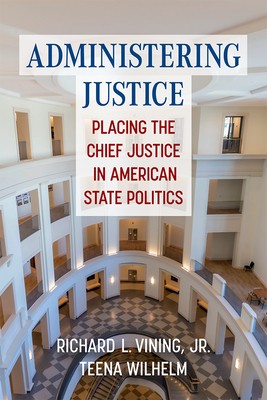
- We will send in 10–14 business days.
- Author: Richard Vining
- Publisher: University of Michigan Press
- ISBN-10: 0472056301
- ISBN-13: 9780472056309
- Format: 15.5 x 23 x 0.6 cm, minkšti viršeliai
- Language: English
- SAVE -10% with code: EXTRA
Reviews
Description
Administering Justice examines the leadership role of chief justices in the American states, including how those duties require chief justices to be part of the broader state political environment. Vining and Wilhelm focus extensively on the power of chief justices as public spokespersons, legislative liaisons, and reform leaders. In contrast to much existing research on states' chief justices, theirs is primarily on their extrajudicial responsibilities rather than intracourt leadership. They analyze the reform agendas advanced by chief justices by assessing the content of State of the Judiciary remarks delivered over a period of sixty years. The authors also determine what factors influence the likelihood of success when chief justices request legislators to enact reforms. These analyses confirm that chief justices engage with state politics in meaningful ways and that reactions to their proposals are influenced by ideological congruence with other political elites and the scope of their requests. They also examine the chief justice position as an institution, provide a collective profile of its occupants, and examine growing diversity among court leaders.
EXTRA 10 % discount with code: EXTRA
The promotion ends in 21d.11:38:28
The discount code is valid when purchasing from 10 €. Discounts do not stack.
- Author: Richard Vining
- Publisher: University of Michigan Press
- ISBN-10: 0472056301
- ISBN-13: 9780472056309
- Format: 15.5 x 23 x 0.6 cm, minkšti viršeliai
- Language: English English
Administering Justice examines the leadership role of chief justices in the American states, including how those duties require chief justices to be part of the broader state political environment. Vining and Wilhelm focus extensively on the power of chief justices as public spokespersons, legislative liaisons, and reform leaders. In contrast to much existing research on states' chief justices, theirs is primarily on their extrajudicial responsibilities rather than intracourt leadership. They analyze the reform agendas advanced by chief justices by assessing the content of State of the Judiciary remarks delivered over a period of sixty years. The authors also determine what factors influence the likelihood of success when chief justices request legislators to enact reforms. These analyses confirm that chief justices engage with state politics in meaningful ways and that reactions to their proposals are influenced by ideological congruence with other political elites and the scope of their requests. They also examine the chief justice position as an institution, provide a collective profile of its occupants, and examine growing diversity among court leaders.


Reviews